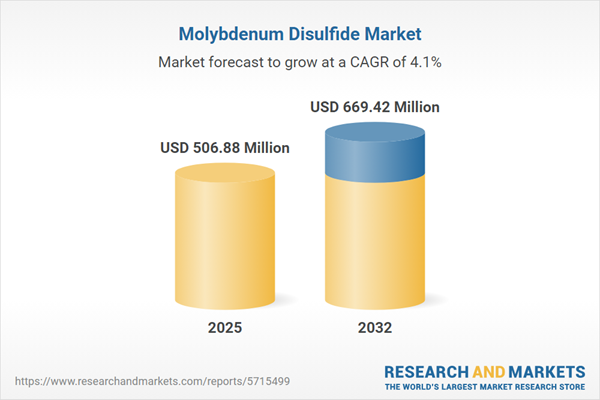Speak directly to the analyst to clarify any post sales queries you may have.
Molybdenum disulfide is advancing rapidly as industries seek robust materials capable of meeting evolving technical, sustainability, and regulatory challenges. Its performance and versatility are driving significant adoption in critical sectors, making its markets and enabling technologies central considerations for executive decision-makers.
Market Snapshot: Molybdenum Disulfide Market Size and Growth Path
The Molybdenum Disulfide Market grew from USD 487.08 million in 2024 to USD 506.88 million in 2025. It is projected to expand further at a CAGR of 4.05%, reaching USD 669.42 million by 2032.
Scope & Segmentation of the Molybdenum Disulfide Market
This report provides a detailed assessment of the molybdenum disulfide landscape, structuring analysis around the following market subsegments:
- Grade: Bulk (includes Industrial Grade and Technical Grade), Catalyst (Premium Catalyst Grade, Standard Catalyst Grade), and Electronic (Semiconductor Grade, Ultra-High Purity Grade).
- Form: Flake (Bulk Flake, Exfoliated Flake), Nanoparticles (Nanoplates, Spherical Nanoparticles), and Powder (Micron Powder, Nano Powder).
- End-User Industry: Aerospace (Commercial Aerospace, Defense), Automotive (Commercial Vehicles, Passenger Vehicles), Chemical Processing (Additive Manufacturing, Catalyst Manufacturing), and Electronics (Consumer Electronics, Industrial Electronics).
- Application: Battery Materials (Lithium Ion Batteries, Solid State Batteries), Catalyst (Chemical Synthesis, Petrochemical Catalyst), Electronics (Semiconductors, Wearable Electronics), and Lubricant Additives (Automotive Lubricants, Industrial Lubricants).
- Geographies: Americas (United States, Canada, Mexico, Brazil, Argentina, Chile, Colombia, Peru), EMEA (United Kingdom, Germany, France, Russia, Italy, Spain, Netherlands, Sweden, Poland, Switzerland, United Arab Emirates, Saudi Arabia, Qatar, Turkey, Israel, South Africa, Nigeria, Egypt, Kenya), Asia-Pacific (China, India, Japan, Australia, South Korea, Indonesia, Thailand, Malaysia, Singapore, Taiwan).
- Leading Companies: Freeport-McMoRan Inc., China Molybdenum Co., Ltd., Albemarle Corporation, Merck KGaA, Quaker Chemical Corporation, Solvay S.A., BASF SE, 3M Company, The Dow Chemical Company, NanoXplore Inc.
Recent Technology and Industry Dynamics
Market participants are deploying advanced manufacturing methods such as chemical vapor deposition and liquid-phase exfoliation to improve film properties for coatings, semiconductors, and energy storage. Pilot-scale expansions and AI-driven material discovery are accelerating tailored product development. Emerging applications in flexible electronics and battery technologies reflect a growing focus on sustainability and performance optimization.
Key Takeaways for Senior Decision-Makers
- Strategic shifts in global production are driven by the demand for high-performance and environmentally-aligned materials.
- Multi-dimensional segmentation unlocks opportunities for product differentiation by form, grade, and advanced technology use.
- Collaborative R&D and digital traceability are becoming critical in aligning with regulatory compliance and resilience strategies.
- Vertical integration and supplier diversification help offset procurement risks and support agile responses to policy changes.
- Regional innovation ecosystems, particularly in Asia-Pacific and EMEA, are influencing the adoption of novel applications and supporting local manufacturing growth.
Molybdenum Disulfide Market Tariff Impact
Recent United States tariff measures have initiated complex adjustments in specialty chemical supply chains. Companies are recalibrating sourcing, expanding domestic operations, and exploring trade zones to control costs and maintain market access. These actions reflect the necessity to balance compliance, resilience, and competitive pricing in the face of shifting trade and regulatory parameters.
Research Methodology & Data Sources
This report employs a combination of primary interviews with senior executives, engineers, and technology partners alongside secondary research from peer-reviewed publications, industry reports, and independent patent reviews. Data triangulation and expert panel validation ensure robust and actionable market insights.
Why This Report Matters
- Provides clarity on evolving industrial applications, market drivers, and the impact of regulatory change for molybdenum disulfide.
- Informs strategic investments in technology, supply chain design, and geographic expansion based on reliable market and segmentation analysis.
- Supports executive decision-making with a concise synthesis of technical trends, application opportunities, and competitive positioning.
Conclusion
Molybdenum disulfide’s role is quickly evolving as businesses seek durability, innovation, and regulatory alignment. This report offers vital intelligence for leaders developing flexible strategies and resilient operations in dynamic markets.
Additional Product Information:
- Purchase of this report includes 1 year online access with quarterly updates.
- This report can be updated on request. Please contact our Customer Experience team using the Ask a Question widget on our website.
Table of Contents
3. Executive Summary
4. Market Overview
7. Cumulative Impact of Artificial Intelligence 2025
Companies Mentioned
The companies profiled in this Molybdenum Disulfide market report include:- Freeport-McMoRan Inc.
- China Molybdenum Co., Ltd.
- Albemarle Corporation
- Merck KGaA
- Quaker Chemical Corporation
- Solvay S.A.
- BASF SE
- 3M Company
- The Dow Chemical Company
- NanoXplore Inc.
Table Information
| Report Attribute | Details |
|---|---|
| No. of Pages | 193 |
| Published | October 2025 |
| Forecast Period | 2025 - 2032 |
| Estimated Market Value ( USD | $ 506.88 Million |
| Forecasted Market Value ( USD | $ 669.42 Million |
| Compound Annual Growth Rate | 4.0% |
| Regions Covered | Global |
| No. of Companies Mentioned | 11 |









